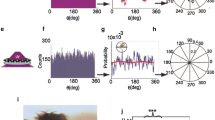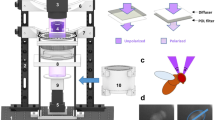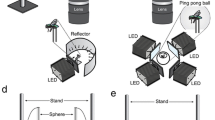Summary
- 1.:
-
Tethered flies (Musca domestica) walking on an air-suspended ball show a spontaneous response to the e-vector of polarized light presented from above, i.e. a slowly rotating e-vector induces periodic changes in the flies' turning tendency. Suitable control experiments exclude the possibility that the response is elicited by intensity gradients in the stimulus (Figs. 1 and 2).
- 2.:
-
Presence of the e-vector response in both white and UV light and its complete absence in yellow light equally support the concept that the specialized dorsal rim area of the compound eye with its highly polarization sensitive UV receptors R7marg and R8marg mediates polarization vision in flies (Fig. 3).
- 3.:
-
E-vector orientations inducing no turning response additional to the fly's inherent turning tendency are either parallel (avoided e-vector) or perpendicular (preferred e-vector) to the animal's body axis (Figs. 1 and 4).
- 4.:
-
Considering the fanlike arrangement of the microvillar orientations of R7marg and R8marg in the dorsal rim area of the eye of Calliphora and Musca, a stabilizing function of polarization vision in controlling the flight course is suggested and discussed in the context of results from other behavioural studies.
Similar content being viewed by others
Abbreviations
- DRA :
-
dorsal rim area
- PS :
-
polarization sensitivity
References
Batschelet E (1981) Circular statistics in biology. Academic Press. London
Bernard GD, Wehner R (1977) Functional similarities between polarization vision and colour vision. Vision Res 17:1019–1028
Brunner D, Labhart T (1987) Behavioural evidence for polarization vision in crickets. Physiol Entomol 12:1–10
Buchner E (1976) Elementary movement detectors in an insect visual system. Biol Cybern 24:85–101
Burghause FMHR (1979) Die strukturelle Spezialisierung des dorsalen Augenteils der Grillen (Orthoptera, Grylloidea). Zool Jahrb Abt Allg Zool Physiol Tiere 83:502–525
Coombe PE (1984) The role of retinula cell types in fixation behaviour of walking Drosophila melanogaster. J Comp Physiol A 155:661–672
Dübendorfer A (1971) Untersuchungen zum Anlageplan und Determinationszustand der weiblichen Genitalund Analprimordien von Musca domestica L. Wilhelm Roux' Arch Entwick-lungsmech Org 168:142–168
Fent K (1985) Himmelsorientierung bei der Wüstenameise Cataglyphis bicolor: Bedeutung von Komplexaugen und Ocellen. Dissertation Universität Zürich
Hardie RC (1984) Properties of photoreceptors R7 and R8 in dorsal marginal ommatidia in the compound eyes of Musca and Calliphora. J Comp Physiol A 154:157–165
Hardie RC (1985) Functional organization of the fly retina. In: Autrum H et al. (eds) Prog Sensory Physiol vol 5. Springer, Berlin Heidelberg New York, pp 2–79
Hardie RC (1986) The photoreceptor array of the dipteran retina. Trends Neurosci 9:419–423
Herrling PL (1976) Regional distribution of three ultrastructural retinula types in the retina of Cataglyphis bicolor Fabr. (Formicidae, Hymenoptera). Cell Tissue Res 169:247–266
Herzmann D, Labhart T (1989) Spectral sensitivity and absolute threshold of polarization vision in crickets: a behavioural study. J Comp Physiol A 165:315–319
Labhart T (1973) Verhaltensphysiologische Bestimmung der Intensitätsund Spektralempfindlichkeit der Honigbiene, Apis mellifera. Dissertation Universität Zürich
Labhart T (1980) Specialized photoreceptors at the dorsal rim of the honey bee's compound eye: polarizational and angular sensitivity. J Comp Physiol 141:19–30
Labhart T (1986) The electrophysiology of photoreceptors in different eye regions of the desert ant, Cataglyphis bicolor. J Comp Physiol A 158:1–7
Labhart T (1988) Polarization-opponent interneurons in the insect visual system. Nature 331:435–437
Labhart T, Hodel B, Valenzuela I (1984) The physiology of the cricket's compound eye with particular reference to the anatomically specialized dorsal rim area. J Comp Physiol A 155:289–296
Meyer EP, Labhart T (1981) Pore canals in the cornea of a functionally specialized area of the honey bee's compound eye. Cell Tissue Res 216:491–501
Räber WF (1979) Retinatopographie und Sehfeldtopologie des Komplexauges von Cataglyphis bicolor (Formicidae, Hymenoptera) und einiger verwandter Formiciden-Arten. Dissertation Universität Zürich
Sachs L (1969) Statistische Auswertungsmethoden. Springer, Berlin Heidelberg New York
Schümperli RA (1972) Wavelength-specific behavioural reactions in Drosophila melanogaster. In: Wehner R (ed) Information processing in the visual systems of arthropods. Springer, Berlin Heidelberg New York, pp 155–161
Sommer EW (1979) Untersuchungen zur topographischen Anatomie der Retina und zur Sehfeldtopologie im Auge der Honigbiene, Apis mellifera (Hymenoptera). Dissertation Universität Zürich
Strausfeld NJ, Wunderer H (1985) Optic lobe projections of marginal ommatidia in Calliphora erythrocephala specialized for detecting polarized light. Cell Tissue Res 242:163–178
Tinbergen J, Abeln RG (1983) Spectral sensitivity of the landing blowfly. J Comp Physiol 150:319–328
Wada S (1974) Spezielle randzonale Ommatidien der Fliegen (Diptera: Brachycera): Architektur und Verteilung in den Komplexaugen. Z Morphol Tiere 77:87–125
Wehner R (1981) Spatial vision in arthropods. In: Autrum H (ed) Vision in invertebrates. Comparative physiology and evolution (Handbook of sensory physiology VII/6C). Springer, Berlin Heidelberg New York, pp 287–616
Wehner R (1982) Himmelsnavigation bei Insekten: Neurophysiologie und Verhalten. Neujahrsblatt Naturforsch Ges Zürich 184:1–132
Wehner R, Strasser S (1985) The POL area of the honey bee's eye: behavioural evidence. Physiol Entomol 10:337–349
Wehner R, Bernard GD, Geiger E (1975) Twisted and non-twisted rhabdoms and their significance for polarization detection in the bee. J Comp Physiol 104:225–245
Wellington WG (1953) Motor responses evoked by the dorsal ocelli of Sarcophaga aldrichi Parker, and the orientation of the fly to plane polarized light. Nature 172:1177–1179
Wellington WG (1974) Changes in mosquito flight associated with natural changes in polarized light. Can Entomol 106:941–948
Wolf R, Gebhardt B, Gademann R, Heisenberg M (1980) Polarization sensitivity of course control in Drosophila melanogaster. J Comp Physiol 139:177–191
Wunderer H, Smola U (1982a) Fine structure of ommatidia at the dorsal eye margin of Calliphora erythrocephala Meigen (Diptera: Calliphoridae): an eye region specialized for the detection of polarized light. Int J Insect Morphol Embryol 11:25–38
Wunderer H, Smola U (1982b) Morphological differentiation of the central visual cells R7/8 in various regions of the blow-fly eye. Tissue Cell 14:341–358
Author information
Authors and Affiliations
Rights and permissions
About this article
Cite this article
von Philipsborn, A., Labhart, T. A behavioural study of polarization vision in the fly, Musca domestica . J Comp Physiol A 167, 737–743 (1990). https://doi.org/10.1007/BF00189764
Accepted:
Issue Date:
DOI: https://doi.org/10.1007/BF00189764




